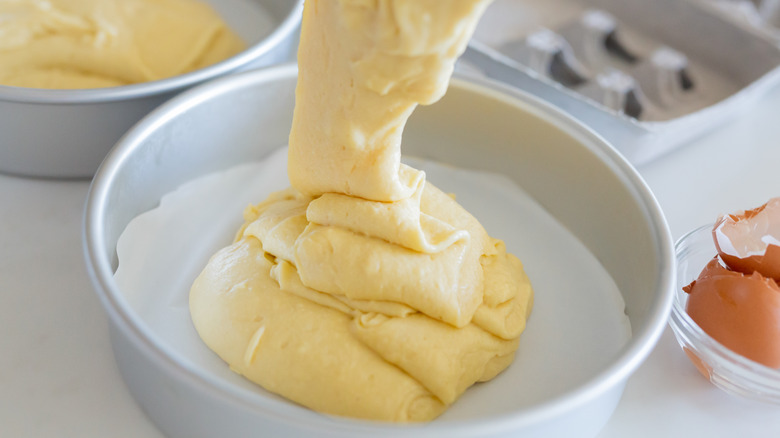The Rule To Remember For Filling Baking Pans With Batter
There are many pitfalls to avoid in baking, from the way you mix your batter to how you soften your butter. One slippery issue is how much batter a baker should add to the pan. Perhaps a recipe was too vague or you've traded a nine-inch cake pan for an eight-inch one. Whatever the reason, you're a little unsure of how much batter your cake pan can take, lest it overflow and make a mess in your oven.
Luckily, there's a rule that you can follow to help guide you're baking endeavors. You can rely on a 2/3 full rule for thick batters as these heavy batters won't rise too dramatically. For sponge cakes, 1/2 full is the way to go, as the many foamy bubbles within the batter will help it rise twice as tall. This seems simple enough on the face of it, but let's break down this tip a bit further.
How to fill your cake pans
First, let's address what we mean when discussing heavy batters. These are your pound cakes, butter cakes, and various quick breads, where sugar-butter creaming or chemical leavenings (baking soda or baking powder) are used to give the cake lift. Whether it's a bundt pan, muffin tin, or a traditional round cake pan, you can count on 2/3 full to accommodate for the batter's upward mobility in the oven.
Meanwhile, sponge cakes refer to chiffon cakes, angel food cakes, and any other cake that uses an egg foam to power its lofty rise. These cakes are known to nearly double in size, so any pan you choose should be filled halfway for safety. Still a little confused about where your cake batter lands on the dense or light spectrum?
Go with the safer 1/2 full method, as hedging your bets is the better option than cleaning up an explosive batter mess on the bottom of the oven. And if you have any leftover batter, pop it in a mini-loaf pan or a muffin tin so that you make the most of your mix. You'll need to cut the bake time way down (keep an eye on it), but otherwise, it should give you a nice mini-cake option.

